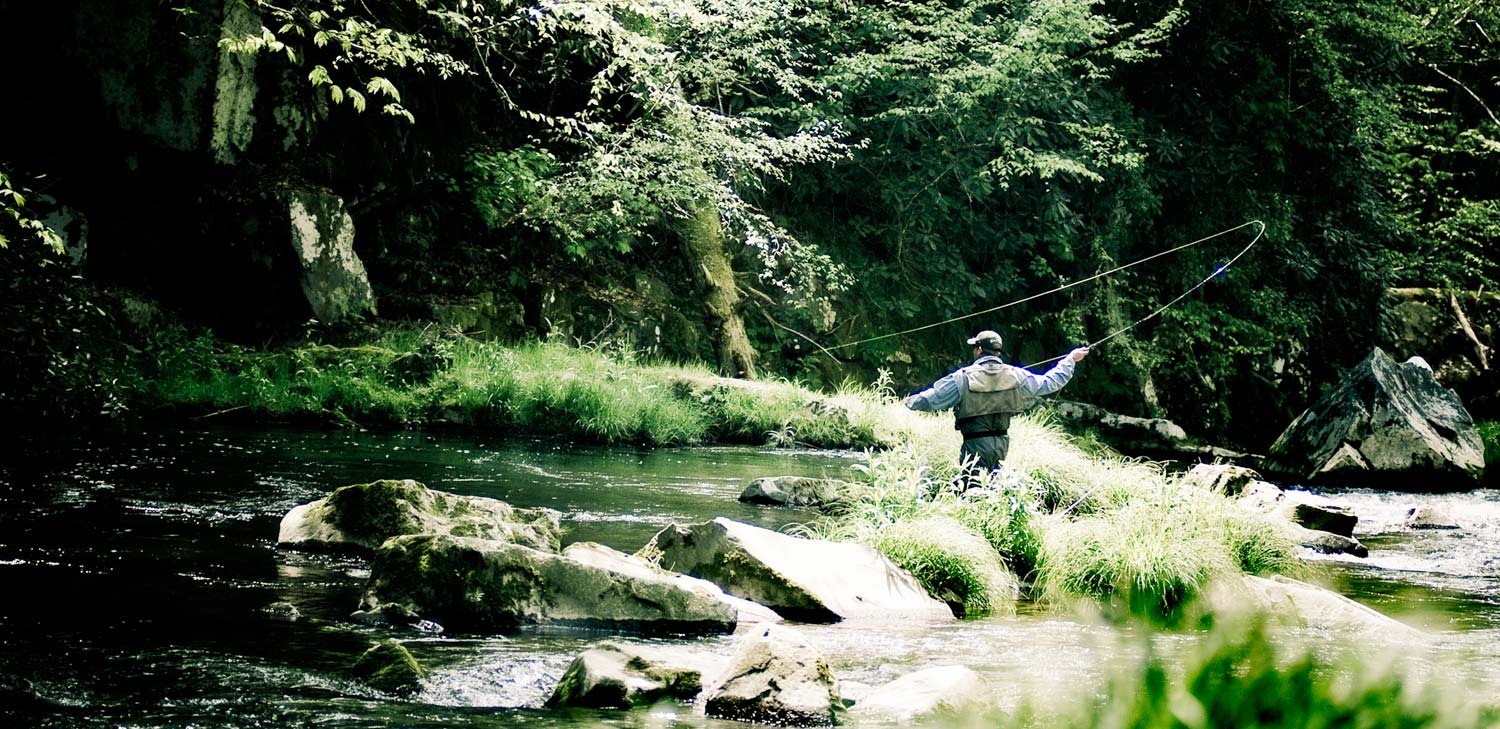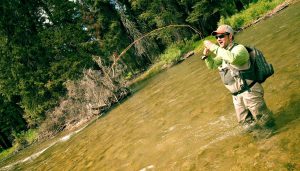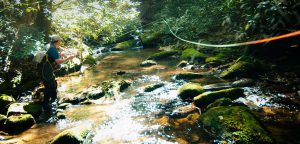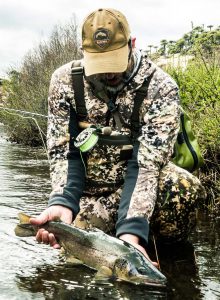
Photos by Louis Cahill
By Jason Tucker
Fly gear is fly gear- until you find yourself on a tiny creek full of brook trout or cutthroat rising to tricos and all you have is a nine-foot five-weight and 4x tippet.
What works on the big rivers may not be so well suited to small-stream fishing. They make zero weight rods for a reason. And the rig you choose can make or break your day on a small stream. You can use that five-weight, but you may not be able to fish so well in tight quarters.
Rods. I have indeed cast a zero weight Orvis rod, but that is not typically what you want on a small stream. You want something in between. You want something short, light and strong. I’ll leave it up to you to find the perfect combination but take a hard look at fiberglass. Rods can take a beating in tight quarters. Glass is almost impossible to break, it is very forgiving on light tippet, and it roll casts like a dream, a must on small streams. Blanks in the five to seven-foot range work nicely. One of my go-to small stream rods is a seven-foot, six-inch Eagle Claw 5/6 weight. I haven’t found a lighter one yet, but even small fish put a nice bend in it. It takes a beating riding around my vehicle without a case, and If I break it, it’s thirty bucks to replace, yet it casts very nicely. There are, of course, many fine and more expensive glass rods out there, and they are often works of art and a dream to cast, so knock yourself out.
 Graphite is still an option, but look for one of the softer actions and shorter blanks that are coming out these days. For many small streams a rod in the six to seven foot range is ideal. As far as line weight, three and four weight rods work nicely; five weight will often feel heavy and spook fish, and a two-weight rod may not have the power to keep bigger fish out of the brush. Use your judgement. It’s just fishing.
Graphite is still an option, but look for one of the softer actions and shorter blanks that are coming out these days. For many small streams a rod in the six to seven foot range is ideal. As far as line weight, three and four weight rods work nicely; five weight will often feel heavy and spook fish, and a two-weight rod may not have the power to keep bigger fish out of the brush. Use your judgement. It’s just fishing.
Reels. Don’t overthink them, and definitely don’t overspend. You typically won’t need your drag, and if you’re smart you’ll land most of your fish by stripping in line rather than reeling your line in. Any serviceable click and pawl model will get it done. Dig up Granddads old Pflueger and you’re all set. Most of the major manufacturers offer a basic trout reel for a modest price.
Lines. Any good weight-forward floating line that matches your rod will do. A double-taper that offers a gentler presentation is nice too. The less disturbance you make on the water, the better, so go as light as you can while still being able to stop fish. Just know that that five-weight line often hits small-stream water with a thud that spooks fish in such tight quarters.
 I have taken to using a light and short sink-tip line for streamer fishing small streams. It can be tricky to use, but it does help to get your streamer down to the fish. You don’t have to use a sink-tip on most small streams especially if you are using weighted streamers, and the heavier splash of a landing sink tip can be detrimental to the fishing. In some situations, and with weightless streamers, a sink-tip can get the fly down those few inches that make a difference. It’s a matter of knowing the stream and using your best judgement. Carrying a spare spool or reel with a sink-tip is a good idea so that you’re not married to it.
I have taken to using a light and short sink-tip line for streamer fishing small streams. It can be tricky to use, but it does help to get your streamer down to the fish. You don’t have to use a sink-tip on most small streams especially if you are using weighted streamers, and the heavier splash of a landing sink tip can be detrimental to the fishing. In some situations, and with weightless streamers, a sink-tip can get the fly down those few inches that make a difference. It’s a matter of knowing the stream and using your best judgement. Carrying a spare spool or reel with a sink-tip is a good idea so that you’re not married to it.
Leader and Tippet. I use 9 foot, 5X tapered leaders, or 4X and tie on 5X tippet. You won’t want a long leader on most small streams. For fishing skunks or muddler minnows I’ll use a three to four foot long piece of 4X, six foot if the water is clear and the fish are shy. For streamers I’ll use four feet of 8 lb. test, and up it to 10 lb. test if I’m using weighted streamers or start snapping them off for no reason. For tricos and those tiny fat BWO’s that hatch in the fall (or any random time for that matter) I’ll go to 6X or even 7X, but for a lot of the small streams I fish you won’t get away with the long leaders you see on the main stream. If I’m there for the trico hatch I tie on a 6X tapered leader; otherwise I just keep 6X tippet in my pack in case a tiny hatch happens and I feel the need to match it. It’s difficult to get fish to go for 5X on size 18 flies and smaller. Fiberglass rods in 3 to 4 weight really shine for this light work.
 Waders. I used to wet wade small streams in Michigan in summer, but I kept getting leeches so I stopped. Just get the best pair of lightweight, breathable waders you can afford. Here in the South wet wading is very popular, and wearing waders is nearly impossible in the heat and humidity of summer. It may still be a good idea to wear your wading boots with some wading socks for the hike in and out and to deal with the rocks. You’ll want to keep a good eye out for snakes, but waders won’t stop those anyhow.
Waders. I used to wet wade small streams in Michigan in summer, but I kept getting leeches so I stopped. Just get the best pair of lightweight, breathable waders you can afford. Here in the South wet wading is very popular, and wearing waders is nearly impossible in the heat and humidity of summer. It may still be a good idea to wear your wading boots with some wading socks for the hike in and out and to deal with the rocks. You’ll want to keep a good eye out for snakes, but waders won’t stop those anyhow.
Sun and bug gear. You may not realize it, but those tag alder swamps are incredibly exposed. I have been caught out when the fog burns off, and the sun glares down on the water. It is not friendly. You need to cover up. I am not a big believer in sun screens. I believe in modern fabrics that cover my skin, screen out the sun and protect me from insects. Orvis, Simms, and other great fly gear companies have comfortable and stylish options that keep the sun and bugs off. Columbia makes some great, less expensive shirts that I like that keep me comfortable in all conditions. I’ll wear a Buff or other sun mask, or a fisherman’s hat with that covers my neck also. A little sunscreen on the face and you’re all set.
I hate DEET, but it can be a necessary evil. My bug protection regime has evolved over the years. Now I buy permethrin spray and pre-treat my fishing clothes, hats and neck gaiters (Buff). It repels and even kills biting insects including ticks, without having to spray my whole body with DEET. I wear the lightweight, breathable clothing mentioned above, and a loose fit also helps confound critters. I buy DEET spray to treat exposed skin. It lasts a long time, and you won’t sweat it off. Pay attention to your elbows- they can be easy to miss, and mosquitoes seem to target elbows. In extreme bug conditions I’ve had to wear a lightweight breathable rain jacket over my waders with the hood up, and douse my neck gaiter, face and hands with DEET. Keep in mind DEET can destroy some plastics and fabrics, and you don’t want it on your fly lines or leaders. This sounds like a lot to go through, but sometimes the fishing is worth it.
Miscellaneous. Hemos for sure. Nippers of course. I got tired of my nets snagging on bushes and woody debris and haven’t used one for years but use one if you must. Try to get a net that is gentle on the fish. You’ll want a good pair of polarized sunglasses. These days I also have to take some reading glasses for tying knots. Basically, take whatever tools, floatant and supplies you use on bigger water. I try to travel as light as possible. Sometimes I just cram a dozen flies into a small container and that’s it. It’s often possible to cram everything I need into the chest pocket of my waders. That’s the beauty of fishing small streams.
Jason writes the fine blog Fontinalis Rising
Jason Tucker
Gink & Gasoline www.ginkandgasoline.com hookups@ginkandgasoline.com Sign Up For Our Weekly Newsletter!
Pingback: Fly Fishing Gear For Small Streams | Latest Fishing Blogs Posts
fantastic article on navigating small streams – unless you practice this type of casting often you’re like a fish out of water (pun intended) !
I jokingly say that Wright & McGill has the best warranty / replacement policy in the fly fishing industry. If anything goes wrong with an Eagle Claw Featherlight rod, you simply return to the nearest W&M authorized dealer (which are many) , plop down $30 and walk out the door with a new rod. No questions asked, no shipping/handling fees, no waiting for time consuming repairs – you’re back on the water right away.
All joking aside, excellent advice for gearing up to fish tiny cricks.
Pingback: Gear for Fishing Small Streams | MidCurrent
Thanks for the great blog! I fish some small streams you can not wade because of steep banks and deep, very clear water. After some trial and error, I found that my 11 ft. 3 nymph rod is working best for me. You have to be patient to get through the heavy brush though. I can stay hidden while poking the rod out. I mostly fish with dries and use a line that is easy to roll cast with a horizontal cast.
Cabelas CGR glass rod. I have both a 3 wt and a 4. I buy Pflueger reels at the local flea market for $10. I wanted a double taper line for the 3 wt but they’re hard to find.
Great article. I think a lot of fly fishermen/women don’t change their tactics, nor their gear selection, when they step down from a large river to a small stream. Out here in northern Utah we have quite a few small streams holding Browns and Cutthroats (e.g. Bonneville, Colorado River, Bear Lake, Yellowstone), which require more stealth and finesse to be successful fishing. I am particularly fond of my Orvis Superfine Glass 4-weight, as it’s 7’6″ length and medium action are well suited to small stream fishing.